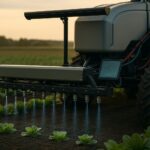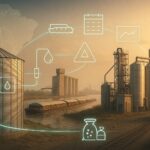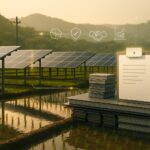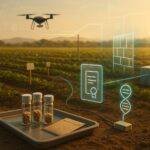In a groundbreaking move for Middle Eastern agriculture, South Korea and Saudi Arabia have jointly launched a state-of-the-art smart-farming hub on the outskirts of Riyadh. Under the desert sun, dignitaries from both nations gathered as the foundation stone was laid on April 21, 2025, symbolizing the fusion of Korean technology with Saudi ambition. Spanning roughly 4,000 square meters, the new complex is anything but a traditional farm. Housed within are futuristic vertical farming racks and climate-controlled greenhouses that will grow everything from leafy greens and strawberries to mushrooms – all in the middle of an arid landscape where such crops could never thrive outdoors. The project’s goal is not only to grow fresh produce, but to showcase how innovation can defy climate limitations. Saudi Deputy Agriculture Minister Mansour Al Mushaiti, who presided over the ceremony, hailed the initiative as “a new chapter in the evolution of modern agriculture” that will “foster innovation in farming and contribute meaningfully to sustainable development and food security in the Middle East”. In short, this high-tech oasis aims to revolutionize farming in the desert, and its implications extend far beyond Saudi Arabia’s borders.
The smart-farming hub – situated at the National Agricultural and Animal Resources Research Center in Riyadh – is designed as a showcase of cutting-edge agricultural technology. From day one, it’s meant to be a living exhibit of what the future of farming could look like in water-scarce regions. Planners say the complex will feature two integrated models: an indoor vertical farm and a glass-paneled greenhouse, each packed with sensors and automation. In the vertical farm, crops will be stacked in tiers under specialized LED lighting and fed by nutrient-rich mist or water solutions (a method known as hydroponics). Next door, the greenhouse will deploy advanced climate-control and irrigation systems imported from Korea, capable of finely tuning water and fertilizer use to the plants’ needs. By controlling variables like light, temperature, and humidity, the facility can essentially create springtime conditions year-round, even as summer temperatures outside soar above 45°C. For Saudi Arabia – a nation that imports the bulk of its food – the promise of growing more food at home with less water is extremely attractive. And for South Korea, it’s a chance to demonstrate its technological prowess on a global stage.
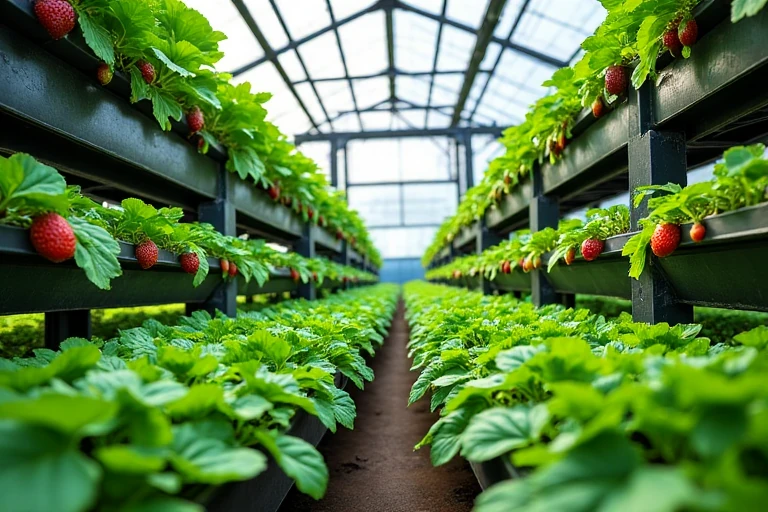
Table of Contents
ToggleAutomation, AI and Robots on the Farm
What truly sets this project apart is the smorgasbord of high-tech tools being applied to agriculture. This is farming reimagined with automation and artificial intelligence at its core. Dozens of Internet-of-Things (IoT) sensors will be embedded throughout the facility, continuously measuring conditions like soil moisture, nutrient levels, and air quality. These sensors feed data into an AI-driven system that can make split-second adjustments – increasing irrigation here, dialing down lighting there – to keep the crops in optimal conditions. According to officials, the AI will even recommend which crops to plant and when, based on data patterns and predictive algorithms. The aim is to squeeze maximum yield out of every drop of water and every ray of light. This data-rich approach marks a leap from the region’s traditional farming, which has often struggled with efficiency. (In fact, Saudi Arabia’s irrigation efficiency has historically been only around 50%, far below the 85% best practices seen elsewhere, a shortfall the government is determined to fix.)
Perhaps the most futuristic element is the introduction of mobile “smart farming” robots that roam the greenhouse floors. These robots, guided by AI, can handle labor-intensive tasks like monitoring plant health, adjusting growth settings, and even harvesting produce. Equipped with computer vision, they’re able to detect subtle signs of pest infestations or nutrient deficiencies far faster than a human scout. The planners claim that by automating such tasks, the facility will more than double production output compared to conventional greenhouses of similar size. In essence, the complex will function like a giant automated factory for vegetables: conveyor belts of lettuce and strawberries moving from germination to packaging with minimal human intervention. It’s a striking vision – farms where farmers are data scientists and robots, rather than plows and hoes, do much of the work. Vice Minister Park Beom-su of South Korea, who attended the launch, emphasized that this collaboration “symbolizes a fusion of Korea’s technological strength with Saudi Arabia’s agricultural ambitions”. Indeed, the project fuses two distinct strengths: Saudi Arabia’s drive for food security and South Korea’s expertise in automation and electronics.
Crucially, the technology is being leveraged to tackle one of the region’s thorniest challenges: water scarcity. The greenhouse’s smart irrigation system is expected to drastically cut water consumption by recycling and precisely targeting water use. “This greenhouse technology helps reduce water usage, optimize fertilizer application, and boost production levels,” noted Al Mushaiti during the launch. For Saudi Arabia, where agriculture still consumes an estimated 80–90% of the country’s freshwater, such efficiency gains are not just welcome – they’re essential. Every sensor and robotic arm in the Riyadh facility ultimately serves a larger purpose: growing more crop per drop of water. It’s a mantra that smart farms around the world, from California to Abu Dhabi, are embracing, but here it carries existential weight. In a desert kingdom that once drained ancient aquifers trying to grow wheat in the 1980s, only to abandon that experiment to save water, the pivot to high-tech, water-sparing agriculture marks a profound shift. The new hub is poised to demonstrate that with enough tech, even the most water-starved lands can bloom green.
Strategic Objectives Beyond Technology
Beyond the gadgets and gizmos, this Saudi-Korean venture is driven by strategic objectives on both sides. For Saudi Arabia, the smart farm hub aligns tightly with its national Vision 2030 goals of diversifying the economy and bolstering food security. The Kingdom has learned the hard way that food security and water security go hand in hand – you can’t have one without careful attention to the other. By investing in smart agriculture, Saudi Arabia hopes to produce more food domestically without wreaking havoc on its limited water resources. Officials have repeatedly framed this project as part of a sustainability push. “It is designed to foster innovation in farming and contribute meaningfully to sustainable development and food security in the Middle East,” Al Mushaiti said of the new complex. In practical terms, Saudi planners envision this Riyadh hub as a training ground for the next generation of farmers and agritech entrepreneurs. It will be a place to test what works and then roll out successful models across the country – whether that means more vertical farms near cities or retrofitting existing farms with smarter irrigation controls. There’s also a regional leadership angle: if this initiative thrives, Saudi Arabia can position itself as a trendsetter in sustainable desert agriculture, potentially exporting its know-how to neighboring countries facing similar climate challenges.
For South Korea, meanwhile, the venture is a bold play to expand its economic footprint in the Middle East through technology. South Korea is better known as an exporter of cars, electronics, and ships – but in recent years it has quietly been cultivating an agtech export strategy. Korean officials have described this Riyadh hub as an “export base” for Korean smart farm technology in the Middle East. In fact, it’s part of a series of overseas demonstration projects: Seoul has already set up pilot smart farms in countries like Vietnam and Australia to showcase its agricultural innovations, and now it’s turning to the Gulf. The choice of Saudi Arabia is hardly accidental. The Kingdom, with its deep pockets and urgent food security needs, is an ideal partner to bankroll such cutting-edge projects. By delivering visible results in Riyadh – say, lettuce yields twice that of a normal greenhouse, or water usage half of conventional farms – South Korea is effectively marketing its agtech to the wider region. It’s telling that this project was announced just months after Seoul inked a broader economic deal with the Gulf states: in early 2024, South Korea clinched a free trade agreement with the Gulf Cooperation Council, and notably, that pact included special cooperation annexes on “smart farming” and advanced technology. Clearly, Korea sees agriculture technology as a promising new pillar of its trade with oil-rich Gulf countries.
There’s also a soft power and diplomacy dimension. High-tech agriculture might not be as flashy as selling fighter jets or building oil refineries, but it addresses a human security issue – food – that resonates deeply in the Middle East. By helping Saudi Arabia and its neighbors grow food more sustainably, South Korea strengthens its friendship and influence in a region where traditionally the U.S. and Europe, and more recently China, have been very active. As Vice Minister Park noted, this partnership marries Korea’s tech strengths with Saudi Arabia’s vision. Implicit in that message is a gentle nod to the idea of a “win-win” development model, one that South Korea, with its own history of rapid agricultural modernization, is well-positioned to offer. And for Riyadh, having multiple international partners vying to assist its development ambitions fits into its strategy of diversification – not just economic diversification, but geopolitical diversification of partnerships. The smart farm hub is thus as much a diplomatic greenhouse as an agricultural one, cultivating ties alongside tomatoes.
Water-Smart Farming at the Core
No discussion of farming in Saudi Arabia can escape the topic of water, and rightly so. Water is the make-or-break factor for any agricultural project in this part of the world. Saudi Arabia is an arid land that relies heavily on non-renewable groundwater and expensive desalination for its water supply. Astonishingly, nearly 90% of all the water used in Saudi Arabia goes to agriculture – much of it to irrigate livestock fodder and a handful of water-intensive crops. This imbalance has long been recognized as unsustainable. Thus, the smart-farming hub in Riyadh isn’t just about shiny robots; at its heart, it’s about radically improving water productivity. Every technology in the complex, from hydroponics to AI irrigation algorithms, serves that end. Hydroponic vertical farming, for instance, can grow salad greens with as little as 5-10% of the water that traditional open-field farming would require for the same output. A striking recent example comes from neighboring UAE: the Emirates Crop One vertical farm in Dubai – currently the world’s largest indoor farm – uses 95% less water than conventional farming for its 2 million pounds of annual greens production. That kind of water savings is a game-changer. It means that a country can grow food with a fraction of the water footprint, preserving precious aquifers and cutting the costly dependence on desalination.
The Riyadh smart farm is expected to achieve similar efficiencies through a combination of techniques. First, by growing plants in a controlled environment, water loss via evaporation is minimized (the greenhouses are closed loops, so water transpired by plants gets recaptured and reused). Second, precision drip irrigation and misting systems deliver moisture directly to plant roots at the right time and in the right amount, avoiding the massive waste of flood irrigation still common in traditional farms. And third, the facility will likely recycle nutrient solutions – the water that isn’t taken up by plants can be filtered and cycled back into the system, rather than seeping away into the ground. Saudi agriculture officials have been aggressively pursuing these kinds of improvements. In fact, alongside high-profile projects like the Korean hub, Saudi Arabia has partnered with the UN’s Food and Agriculture Organization on initiatives to spread smart irrigation technology to ordinary farms. By 2024, pilot programs in several Saudi regions had introduced farmers to digital sensor-controlled drip irrigation, significantly improving water-use efficiency at those sites. The new Riyadh complex will build on this momentum, serving as a high-profile proof of concept that farming doesn’t have to be a water sinkhole. If successful, it will send a strong message across the Gulf: embracing tech is key to climate resilience in agriculture.
Equally important is the focus on sustainability. Water-saving tech often goes hand in hand with energy-saving and low-carbon practices. The farm’s designers are undoubtedly looking at renewable energy integration (imagine solar panels powering the LED grow lights) and using climate-friendly inputs. Saudi Arabia, after all, is not just aiming to grow more food – it wants to do so in a way that aligns with its pledges to combat climate change and preserve the environment for future generations. Smart farming ticks those boxes by reducing waste and often by producing locally (which cuts down on the carbon footprint of importing produce by airplane). In a region where the term “oasis” evokes ancient images of palm trees and spring water, these new high-tech oases promise a different kind of sustenance: they are oasis of efficiency, conserving every drop and ray in service of sustainability.
U.S. AgTech Faces a New Landscape in MENA
The emergence of this Saudi-Korean smart farm hub also carries important implications for U.S. agricultural technology players eyeing the Middle East and North Africa (MENA) region. American companies have long been major suppliers of agricultural goods and equipment to Gulf countries – from giant John Deere tractors plowing fields in Saudi oases, to advanced irrigation pipes and pumps keeping date palms alive. The United States exported about $1.58 billion worth of agricultural products to Saudi Arabia in 2022 alone, making the Kingdom one of the top twenty markets for U.S. agriculture. However, much of that has traditionally been in the form of commodities (like corn, soy, and meat) or conventional farm machinery. The burgeoning agtech sector – high-tech greenhouses, precision farming systems, robotics – is a newer export domain, and it’s becoming a competitive one. The Riyadh hub’s launch underlines that competition in the MENA agtech arena is heating up: it’s no longer just U.S. and European firms chasing opportunities, but increasingly Asian players like South Korea (and one could add others such as Japan and China) who are coming in with strong government backing.
For U.S. agtech startups and companies, the message is clear: the Gulf region’s pivot to high-tech farming is accelerating, and who gets involved now could shape the market for years to come. Saudi Arabia and its neighbors are investing heavily to turn their desert agriculture more high-tech and self-sufficient. The Saudi government, for example, announced plans to pour over $1 billion into greenhouse projects by 2025 as part of its food security strategy. The United Arab Emirates has been doing the same, investing in massive indoor farming complexes (Dubai’s aforementioned vertical farm was a $40 million joint venture with a U.S. company, Crop One Holdings). Abu Dhabi’s sovereign funds have also lured U.S. agtech firms like AeroFarms to set up R&D centers in the Emirates. In short, the Gulf is becoming a magnet for agtech investment – and U.S. firms are among those vying for a piece of the action.
However, the competitive dynamics are shifting. South Korea’s proactive partnership with Saudi Arabia – underpinned by government ministries and even an FTA that specifically encourages smart-farm cooperation – gives Korean companies a leg up in securing pilot projects and public-sector support in the Gulf. In contrast, U.S. companies often rely more on private enterprise and local distributors to make inroads. While American agribusiness giants (think of irrigation specialists, seed companies, and farming AI startups from Silicon Valley) bring a wealth of expertise, they might need to adapt their approach in the face of state-backed rivals. We may see more U.S. firms seeking partnerships with Gulf government initiatives or teaming up with local companies to remain competitive. There’s also the question of cost: if Korean or other Asian providers can offer smart farm solutions at lower cost (possibly subsidized or supported by their governments), U.S. companies will have to highlight their quality and innovation edge to justify a premium.
It’s not a zero-sum game, of course. The scale of the food security challenge in MENA is so vast that there is plenty of room – and indeed, a pressing need – for multiple players and ideas. American companies continue to be highly respected in fields like farm management software, biotech (seeds and crop genetics), and heavy farm machinery. The U.S. also remains a key partner through broader initiatives such as the Agriculture Innovation Mission for Climate (AIM for Climate), a U.S.-UAE led effort that Saudi Arabia has joined to spur investment in climate-smart agriculture globally. These collaborative platforms mean that American and Korean (and European, and local Middle Eastern) innovators often share a table, not just compete. Yet, when it comes to securing contracts or government support, having an early presence on the ground matters. In that sense, South Korea’s smart farm hub in Riyadh is setting a precedent that others may follow. We might soon see an era of demo farms and innovation hubs across the Gulf: today a Korean-backed one in Saudi, tomorrow perhaps a Japanese-backed vertical farm in Kuwait, or an American-funded agri-tech incubator in Qatar. The race is on to be the go-to partner for Gulf nations determined to modernize farming.
For American agtech firms, one takeaway is the importance of localizing solutions to Middle Eastern conditions. It’s not enough to bring a high-tech product; it has to solve the specific problems of farming in heat, salinity, and water scarcity. The Korean project’s success will hinge on how well their technology actually performs under Saudi conditions – something U.S. engineers will watch closely. If it thrives, it proves that outside technology can be transplanted effectively, which is encouraging for all. If it faces hiccups (say, higher than expected energy costs for cooling, or difficulty in scaling beyond a pilot), that too will offer lessons and openings for others to improve on the model. In any case, the presence of multiple international players raises the profile of agtech in the region as a whole, which can stimulate market growth that benefits everyone. A rising tide lifts all boats, as the saying goes – or perhaps, in this context, a rising greenhouse lifts all crops.
Cultivating the Future: A Thoughtful Path Forward
The story of this smart-farming hub in Riyadh is ultimately a story of hope and adaptation. It signals that even as climate change and resource limits press upon countries, innovative partnerships can yield solutions. Seeing lettuce and strawberries flourishing in a high-tech greenhouse amid Saudi sand dunes is a powerful metaphor: it shows that with ingenuity, the impossible can become possible. For the Middle East, which has watched its food import bill grow year after year, projects like this offer a glimpse of a future where the region can feed itself in a sustainable way. For South Korea, it’s a chance to export not just goods, but a model of development – sharing the fruits of its own post-war agricultural transformation in a contemporary, digital form. And for the United States and other agtech leaders, it’s a wake-up call that the next green revolution will be a globally contested space, one that rewards those who combine technology with on-the-ground partnership.
In conversational terms, one might say: the race to green the deserts is on. And it’s not just about national pride or commercial gain; it’s about reshaping agriculture to meet 21st-century challenges. The Riyadh smart farm hub exemplifies this by tackling core issues like water efficiency, yield improvement, and climate resilience all at once. As we watch the first harvests come out of this facility over the coming months, there will be plenty of curiosity – and healthy skepticism – from observers around the world. Can it truly deliver the promised yields? Will the costs be justified? Can the model scale up to make a dent in Saudi Arabia’s reliance on imported food? These questions will be answered in time. But already, the project has succeeded in sparking a conversation that reaches far beyond Saudi Arabia’s borders.
For American agtech executives reading about this from afar, the takeaway might be a mix of admiration and strategic calculus. Admiration for a bold experiment that is aligning advanced tech with a pressing humanitarian need – and calculus about how to position themselves in a region that is clearly prioritizing agtech like never before. Ultimately, farmers in California’s Central Valley or engineers in a Boston agtech startup share a common cause with agronomists in Riyadh and technologists in Seoul: all are trying to figure out how to grow more with less and do so sustainably. In that sense, the smart-farming hub in Riyadh is not an isolated project, but part of a larger global movement. It just so happens to be one with a unique cast of characters and a very symbolic patch of land. As the complex in Riyadh ramps up, don’t be surprised if it becomes a must-visit site for delegations and executives from around the world – including many from the United States – eager to glean insights and forge connections. In the desert of Saudi Arabia, a green spark has been lit, and its light is drawing international interest. The hope is that it will illuminate a path toward a more food-secure and sustainable future for the region, one high-tech greenhouse at a time.

